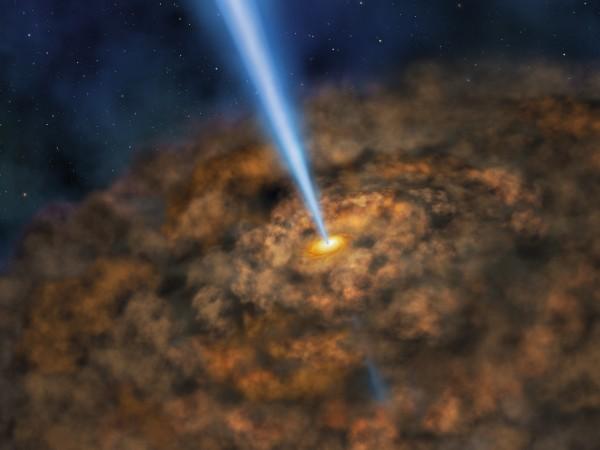
With the help of NASA's SOFIA (Stratospheric Observatory for Infrared Astronomy), researchers at the University of Texas at San Antonio have discovered debris surrounding active, ravenous black holes which were found to be more compact than previously believed.
Also Read: NASA's Aqua satellite spots brightest turquoise swirls in Black Sea
A supermassive black hole is present in the nucleus of most of the galaxies and many of them are found to be pretty inactive just like the one present in the centre of the Milky Way galaxy.
It's also observed that some active supermassive black holes -- active galactic nuclei -- eat away significant amounts of matter which gets sucked into them and then converted into huge energy emissions.
According to previously conducted researches, all active galactic nuclei are found to have the same structure. Models point out that the active galactic nuclei have a donut-shaped dust structure which is called torus and encompasses the supermassive black hole.
Researchers analysed around 11 supermassive black holes in active galactic nuclei with the help of the instrument called the Faint Object InfraRed Camera for the SOFIA Telescope, FORCAST. Located at distances of 100 million light years and more, their size, opacity and distribution of dust in each torus were assessed.
The researchers found that the tori are 30 percent smaller than they were estimated to be and even the emissions of the infrared wavelengths were found to be longer than they were suggested to be, as per a paper published in the Monthly Notices of the Royal Astronomical Society.
It is also suggested that the dust obscured in the central black hole is more complicated than it was previously believed to be.
The astronomers also pointed out that the active galactic nuclei emit most of their energy at wavelengths which can't be observed from the ground because the energy is absorbed by water vapour in Earth's atmosphere.
SOFIA flies above 99 percent of the Earth's water vapor, enabling the research group to characterise the properties of the torus-shaped debris structures at far-infrared wavelengths.
"Using SOFIA, we were able to obtain the most spatially detailed observations possible at these wavelengths, allowing us to make new discoveries on the characterisation of active galactic nuclei dust tori," said Lindsay Fuller, a graduate student at the University of Texas at San Antonio and lead author of the published paper.
It's crucial to make future observations to determine whether or not all of the observed emission originates with the tori, or if there is some other component adding to the total emission of the active galactic nuclei.
"Next, our goal will be to use SOFIA to observe a larger sample of active galactic nuclei and at longer wavelengths. That will allow us to put tighter constraints on the physical structure of the dusty environment surrounding the active galactic nuclei," said Enrique Lopez-Rodriguez, principal investigator of this project and Universities Space Research Association staff scientist at the SOFIA Science Center.
SOFIA is a Boeing 747SP jetliner modified to carry a 100-inch diameter telescope. It is a joint project of NASA and the German Aerospace Center, DLR. NASA's Ames Research Center in California's Silicon Valley manages the SOFIA program, science and mission operations in cooperation with the Universities Space Research Association headquartered in Columbia, Maryland, and the German SOFIA Institute (DSI) at the University of Stuttgart. The aircraft is based at NASA's Armstrong Flight Research Center's Hangar 703, in Palmdale, California.








